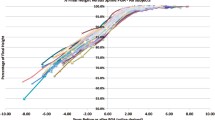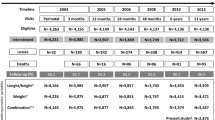Abstract
During puberty, the marked increases in both standing height and bone mass appear to be dissociated in time, the former occurring earlier than the latter. However, the age or pubertal stage at which this dissociation is maximal in girls as opposed to boys, and whether this dissociation is similar at all parts of the skeleton, are not clearly established. Standing height and bone mineral mass, as assessed by measuring areal bone mineral density (BMD), at the levels of the lumbar spine, femoral neck and midfemoral shaft, were measured in 98 females and 100 males between the ages of 9 and 19 years twice at a 1-year interval. In males, the greatest difference between height and BMD gains occurred in the 13–14 year age group and was more pronounced for the lumbar spine and femoral neck than for the midfemoral shaft. In females, the greatest difference was detectable at a younger age (11–12 year age group) and appeared to be of a lower magnitude than in males. In both genders, the maximal difference occurred during the period of peak height velocity, which corresponded to the pubertal stages P2-P3. Such a dissociation between the rates of statural growth and mineral mass accrual could define a state of relatively low bone mass and contribute to the higher incidence of fracture known to occur at the age and/or pubertal stage when this dissociation is maximal.
Similar content being viewed by others
References
Glastre C, Braillon P, David L. Cochat P, Meunier PJ, Delmas PD. Measurement of bone mineral content of the lumbar spine by dual-energy X-ray absorptiometry in normal children: correlations with growth parameters. J Clin Endocrinol Metab 1990;70:1330–3.
Bonjour JP, Theintz G, Buchs B, Slosman D, Rizzoli R. Critical years and stages of puberty for spinal and femoral bone mass accumulation during adolescence. J Clin Endocrinol Metab 1991;73:555–63.
Katzman DK, Bachrach LK, Carter DR, Marcus R. Clinical and anthropometric correlates of bone mineral acquisition in healthy adolescent girls. J Clin Endocrinol Metab 1991;73:1332–9.
Theintz G, Buchs B, Rizzoli R, Slosman D, Clavien H, Sizonenko PC, Bonjour JP. Longitudinal monitoring of bone mass accumulation in healthy adolescents: evidence for a marked reduction after 16 years of age at the levels of lumbar spine and femoral neck in females subjects. J Clin Endocrinol Metab 1992;75:1060–5.
Salle BL, Braillon P, Glorieux FH, Brunet J, Cavero E, Meunier PJ. Lumbar bone mineral content measured by dual-energy X-ray absorptiometry in newborns and infants. Acta Paediatr 1992;81:953–8.
Grimston SK, Morrison K, Harder JA, Hanley DA. Bone mineral density during puberty in Western Canadian children. Bone Miner 1992;19:85–96.
Rubin K, Schirduan V, Gendreau P, Sarfarazi M, Mendola R, Dalsky G. Predictors of axial and peripheral bone mineral density in healthy children and adolescents, with special attention to the role of puberty. J Pediatr 1993;123:863–70.
Bonjour JP, Theintz G, Law F, Slosman D, Rizzoli R. Peak bone mass. Osteoporos Int 1994;4(Suppl 1):S7–13.
Fournier PE, Rizzoli R, Slosman DO, Buchs B, Bonjour JP. Relative contribution of vertebral body and posterior arch in female and male lumbar spine peak bone mass. Osteoporos Int 1994;4:264–72.
Alffram PA, Bauer GCH. Epidemiology of fractures of the forearm: a biomechanical investigation of bone strength. J Bone Joint Surg Am 1962;44:105–14.
Landin L, Nilsson BE. Bone mineral content in children with fractures. Clin Orthop Rel Res 1983;178:292–6.
Bailey DA, Wedge JH, McCulloch RG, Martin AD, Bernhardson SC. Epidemiology of fractures of the distal end of the radius in children as associated with growth. J Bone Joint Surg Am 1989;71:1225–31.
Blimkie CJR, Lefevre J, Beunen GP, Renson R, Dequeker J, Van Damme P. Fractures, physical activity, and growth velocity in adolescent Belgian boys. Med Sci Sports Exerc 1993;25:801–8.
Slosman DO, Rizzoli R, Donath A, Bonjour JP. Vertebral bone mineral density measured laterally by dual-energy X-ray absorptiometry. Osteoporos Int 1990;1:23–9.
Bonjour J-P, Carrie A-L, Ferrari S, Clavien H, Slosman D, Theintz G. Rizzoli R. Calcium-enriched foods and bone mass growth in prepubertal girls: a randomized, double-blind, placebo-controlled trial. J Clin Invest 1997;99:1287–94.
Katzman DK, Bachrach LK, Carter DR, Marcus R. Clinical and anthropometric correlates of bone mineral acquisition in healthy adolescent girls. J Clin Endocrinol Metab 1991;73:1332–9.
Carter DR, Bouxsein ML, Marcus R. New approaches for interpreting projected bone densitometric data. J Bone Miner Res 1992;7:137–45.
Prader A, Largo RH, Molinari L, Issler C. Physical growth of Swiss children from birth to 20 years of age. Helv Paediatr Acta 1988;43(Suppl 52):1–125.
Nathorst Westfelt JAR. Environmental factors in childhood accidents: a prospective study in Goeteborg, Sweden. Acta Paediatr Scand 1982;7(Suppl 291):1–75.
Cheng JCY, Shen WY. Limb fracture pattern in different pediatric age groups: a study of 3350 children. J Orthop Trauma 1993;7:15–22.
Landin LA. Fracture patterns in children: analysis of 8682 fractures with special reference to incidence, etiology and secular changes in a Swedish urban population 1950–1979. Acta Orthop Scand 1983;54(Suppl 202):1–109.
Parfitt AM. The two faces of growth: benefits and risks to bone integrity. Osteoporos Int 1994;4:382–98.
Chan GM, Hess M, Hollis J, Book LS. Bone mineral status in childhood accidental fractures. Am J Dis Child 1984;138:569–70.
Cook SD, Harding AF, Morgan EL, et al. Association of bone mineral density and pediatric fractures. J Pediatr Orthop 1987;7:424–7.
Jensen RK. The growth of children’s moment of inertia. Med Sci Sports Exerc 1986;18:440–5.
Lopez RA, Burke SW, Levine DB, Schneider R. Osteoporosis in Scheuermann’s disease. Spine 1988;13:1099–103.
Gilsanz V, Gibbens DT, Carlson M, King J. Vertebral bone density in Scheuermann’s disease. J Bone Joint Surg Am 1989;71:894–7.
Warren MP, Brooks-Gunn J, Hamilton LH, Waren LF, Hamilton WG. Scoliosis and fractures in young ballet dancers. N Engl J Med 1986;314:1348–53.
Author information
Authors and Affiliations
Rights and permissions
About this article
Cite this article
Fournier, P.E., Rizzoli, R., Slosman, D.O. et al. Asynchrony between the rates of standing height gain and bone mass accumulation during puberty. Osteoporosis Int 7, 525–532 (1997). https://doi.org/10.1007/BF02652557
Received:
Accepted:
Issue Date:
DOI: https://doi.org/10.1007/BF02652557




